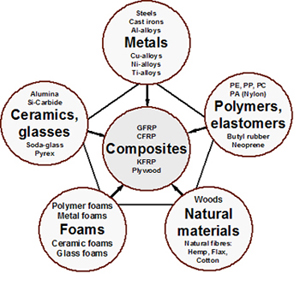Material Science Composites Polymers Ceramics And Metal Differences

Metal ceramic and polymeric composites for various uses.
Material science composites polymers ceramics and metal differences. Roofs floors walls of buildings and in aircraft for wings fuselage and tailplane skins. But composites are made of more than one material they might have two metals. Composite materials combine two or more materials. Composites can yield mixed mode fracture meaning one phase behaves like a ceramic or more elastic while the other behaves like a metal or plastic.
These are typical properties. Had to bend clip multiple times prior to fracture. Ceramics and polymers are made out of one type of material. The matrix is ductile metal.
For example one type of ceramic cordierite a magnesium aluminosilicate is used as a substrate and support for catalysts in catalytic converters. It was chosen for this purpose because along with many ceramics it is lightweight can. Unlike polymers and metals which can be processed by techniques that involve melting or softening followed by solidification high temperature ceramics cannot be melted. Composite materials often shortened to composites are engineered or naturally occurring materials made from two or more constituent materials with significantly different physical or.
Visible permanent set or plastic behavior prior to fracture. Isbn 978 953 307 353 8 pdf isbn 978 953 51 4485 4 published 2011 07 20. Polymers are strong and tough and often flexible. In fact properties of ceramics and glass can be tailored to specific applications by modifying composition including creating composite materials with metals and polymers and by changing processing parameters.
General core materials are. Ceramics play an important role in engine efficiency and pollution abatement in automobiles and trucks. The reinforcement material can be a metal or another ceramic. Ceramics are hard and strong but brittle.
The table below provides a summary of the main properties of ceramics and glass. Let s say but they might have a metal and a ceramic. Metals ceramics polymers. Foamed polymers synthetic rubbers inorganic cements balsa wood.
Clay minerals i e porcelain as well as cement and glass composites materials science. 3 2 composites type based on matrix material 3 2 1 metal matrix composites. Materials science materials science ceramics. Different materials have different properties.
They might have a metal and a polymer or any combination. They are classified according to their physical and chemical structure and properties.














































